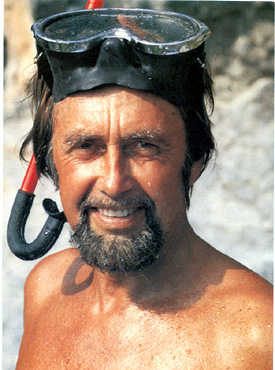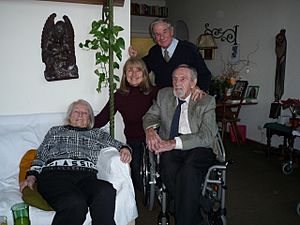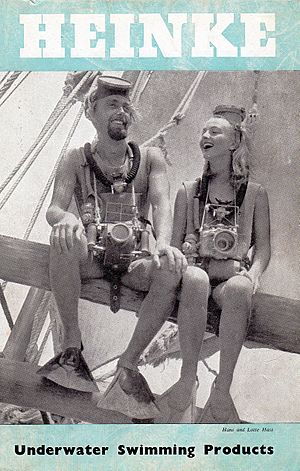Hans Hass facts for kids
Quick facts for kids
Hans Hass
|
|
|---|---|
 |
|
| Born | 23 January 1919 |
| Died | 16 June 2013 (aged 94) |
| Education | University of Berlin |
| Occupation | Underwater diver, Documentary filmmaker |
| Spouse(s) |
|
| Children | 2 |
| Scientific career | |
| Institutions | Universum Film AG, Babelsberg |
Hans Hass (born January 23, 1919 – died June 16, 2013) was an amazing Austrian biologist and a true pioneer in underwater diving. He became famous for being one of the first scientists to show the world the beauty of coral reefs, stingrays, octopuses, and sharks. He was also a leader in making movies filmed underwater. Plus, he helped create a special type of breathing device called a rebreather. Hans Hass was also known for his "energon theory" and his strong dedication to protecting our planet's environment.
Contents
Early Adventures
Hans Hass was born in Vienna, Austria. His dad was a lawyer, and Hans first planned to study law too. But everything changed in 1938 during a holiday on the French Riviera. There, he met an American diver named Guy Gilpatric. Hans learned about underwater hunting and photography from him. This experience really inspired Hans.
After going on trips to the Caribbean Sea and writing his first articles in 1938-1939, Hans decided to change his studies. In 1940, he switched from law to zoology, which is the study of animals. He earned his Ph.D. from the University of Berlin in 1943. His main project for his degree was the first scientific study ever done using a special self-contained rebreather diving suit.
In his early dives, Hans used rebreathers made by a German company called Dräger. He liked the breathing bag to be on his back, not on his chest. From 1942 to 1953, Hans and his team made over 2,000 dives using these oxygen rebreathers.
Some people once thought Hans Hass was responsible for hunting the Atlantic goliath grouper (a very large fish) to extinction in one area. However, this idea was later proven wrong by the author who first mentioned it.
Wartime Work
In 1939, Hans Hass published his first book of underwater photos called "Diving to Adventure." Some people even say he helped develop one of the first underwater cameras. In 1940, he finished his first underwater film called Pirsch unter Wasser (Stalking under Water). This short film was shown in cinemas before the main movie. Later, he added more footage filmed in the Adriatic Sea near Dubrovnik.
In 1941, Hans moved from Vienna to Berlin. There, he started a special group called Expedition für biologische Meereskunde (Expedition for biological oceanography). This group focused on studying the ocean's biology.
Hans Hass did not have to serve in the German military during World War II. This was because he had a health condition that affected the circulation in his feet.
In 1942, Hans bought a sailing ship called Seeteufel with money from his many lectures. But he couldn't use it for his planned trip because the ship was stuck in a harbor far away.
So, Hans rented another ship in Piraeus, Greece. For several months in 1942, he sailed around the Aegean Sea and the Sea of Crete. During this trip, he filmed and took photos underwater. He even filmed a group of fishermen near Skiathos who were using dynamite to catch fish underwater.
In 1943, Hans spent several months in Naples and Capri, Italy. He studied tiny water animals called Bryozoa for his Ph.D. In February 1944, he officially became a Doctor of Science.
Until the end of the war, Hans worked in the film studios near Berlin. He was busy editing his film about his trip to the Aegean Sea. This 84-minute underwater film, Menschen unter Haien (Men among Sharks), was released in 1947. It showed amazing marine life like fish, jellyfish, and rays. A highlight of the film was showing dynamite fishing and divers interacting with sharks.
While working in the film studios, he met Hannelore Schroth, a famous German actress. Hans and Hannelore got married in 1945.
Post-War Success and Fame
After the war, in 1945, Hans's ship Seeteufel was lost.
In 1947, his film Menschen unter Haien premiered in Zurich. His very popular book with a similar name came out in 1948. These successes led to new film contracts. He also started his first expedition with a new research ship called 'Xarifa'. This trip was mostly paid for by photo safaris in the Red Sea and by the BBC.
Hans's marriage to Hannelore Schroth ended in 1950. They had a son named Hans Hass, Jr. Later that same year, Hans married his second wife, Lotte Baierl.
Hans Hass made 105 films, and many of them featured him and his second wife, Lotte, who was also an excellent diver. In 1951, Hans's film Under the Red Sea won first prize at the Venice Film Festival.
After trips to East Africa and South Asia, Hans developed his first TV series in 1959. In 1961, he even made a series about animals outside of water. From 1963 to 1966, he focused on studying animal behavior and developed his 'energon theory'. This theory suggests that all living things – humans, animals, and plants – behave in ways that come from common origins.
In the 1970s, he focused on environmental issues and business topics. He was even made a professor by the University of Vienna. Hans Hass combined marine biology, behavior research, and management ideas. He believed his energon theory could explain a lot about life. In 1989, he focused even more on protecting the environment.
In 1967, the Australian Prime Minister Harold Holt disappeared in the ocean. Hans Hass later visited Australia to explore the area for his 1971 film Das Geheimnis der Cheviot Bay (The Secret of Cheviot Bay). After seeing the sharp rocks and strong currents underwater, Hans believed that Holt had been trapped by the rocks and pulled away by the sea.
Hans Hass also had a friendly rivalry with the famous French scientist Jacques Cousteau. Hans once said that Cousteau didn't always give credit to others or correct the idea that he was the very first in diving or underwater photography.
Hans Hass passed away on June 16, 2013, in Vienna. He was 94 years old. He was survived by his wife, Lotte, and their daughter, Meta. Lotte Hass passed away in January 2015.
In 2002, the Historical Diving Society created the Hans Hass Award. This award honors people who achieve great things in underwater science, technology, or arts and literature around the world.
Diving Innovations
Hans Hass made many important improvements in diving technology:
- 1938: He created a new, lightweight underwater camera for ROBOT cameras.
- 1940: He took the first underwater color photos (near Catalina Island, USA) and made an underwater film.
- 1941: He helped develop the technique of swim diving for research, industry, and sports.
- 1944: He built a prototype of a heliox rebreather (a special breathing device).
- 1949: He developed a new system for deep-sea filming and photography called 'Bathyopthalm'.
- 1949: He received patents around the world for a new way of fishing using radio signals, called 'Elektro-Marina'.
- 1949: He designed the "System Hans Hass" swim fins. These were made by Semperit in Vienna and later by Barakuda and Heinke.
- 1950: He created an underwater camera housing for 'Leica System Hans Hass' with an electronic flash.
- 1954: He developed the 'Rolleimarin System Hans Hass' underwater camera housing, which could also take stereo (3D) photos.
- 1955: He helped develop and promote an underwater watch called ENICAR Sherpa.
- 1956: He designed new patented swim fins called 'Superfish'.
- 1973: He built an underwater habitat (in Almeria, Spain).
- 1977: He helped build a small submarine with a German company for deep-sea research, tourism, and oil exploration.
- 1983: He developed and promoted an innovative decompression computer called 'Deco-Brain'.
Awards and Honors
Hans Hass received many awards for his work:
- First Prize for the "best movie idea for an Austrian propaganda film" (1949)
- Gold Medal of the Photographic Society in Vienna (1950)
- Biennale Prize (1951)
- His film "Adventure in the Red Sea" won the International Prize for documentaries in Venice (1951).
- His TV series "Diving to Adventure" was voted "Programme of the Year" by the BBC (1956).
- Outstanding Underwater Photographer of the Year (USA, 1959)
- Oscar for amazing underwater photography for the film Under the Caribbean (1959).
- Honorary Member of the Association of German Sports Divers (1974).
- Given the honorary title of "Professor" (1977).
- Science Medal of the City of Linz (1987).
- IADS Lifetime Achievement Award (1989).
- Golden Badge of Honour of the Association of German Sports Divers (1994).
- Honorary President of the Sports Diving Support Group (1994).
- Reg Vallintine Achievement Award for Historical Diving (UK, 1994).
- Reaching Out Award (United States; 1997).
- Diving Pioneer Trophy of the Historical Diving Society (USA, 1997).
- Diving Pioneer Award of the Historical Diving Society (Italy, 1997).
- Austrian Decoration for Science and Art (1997).
- Two NOGI Awards for Science and Distinguished Service (USA, 1998).
- Gold Medal of Honour of Vienna (1999).
- Honorary President of the PEN Club Liechtenstein (1999).
- Konrad Lorenz Award for Conservation (1999).
- Golden Medal of Honour of the Austrian Federal Guild of Photographers (1999).
- DANUBIUS Donauland Sachbuchpreis (Danubia Non-Fiction Prize) (1999).
- Goldenes Lot (Gold plumb) award of the Association of German surveyors (1999).
- International Scuba Diving Hall of Fame, 2000.
- Dieter Plage Lifetime Achievement Award for special achievements in nature films (2001).
- Christopher Parsons Award for outstanding achievement in nature films (2004).
- Peace Prize for Biology (2005).
- Cayman Islands International Scuba Diving Hall of Fame Award (2006).
- Wyland ICON Award (2006).
- Beneath the Sea Special Award (2006).
- Pannatura Prize for outstanding services in nature films (2006).
- Schmitz-Salue Medal (2009).
- Elisabeth Mann Borgese marine prize (2009).
- DIVA - German Entertainment Prize (2011).
- Platinum Romy award for lifetime achievement (2012).
- A type of cone snail found in the Philippines was named after him (Protoconus hanshassi) (2012).
- A park in Vienna was named "Hans Hass Park" (2018).
See also
 In Spanish: Hans Hass para niños
In Spanish: Hans Hass para niños
- Hans Hass Award



